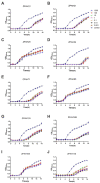Characterization and application of a lytic jumbo phage ZPAH34 against multidrug-resistant Aeromonas hydrophila
- PMID: 37415809
- PMCID: PMC10321303
- DOI: 10.3389/fmicb.2023.1178876
Characterization and application of a lytic jumbo phage ZPAH34 against multidrug-resistant Aeromonas hydrophila
Abstract
Aeromonas hydrophila is an emerging foodborne pathogen causing human gastroenteritis. Aeromonas species isolated from food such as seafood presented multidrug-resistance (MDR), raising serious concerns regarding food safety and public health. The use of phages to infect bacteria is a defense against drug-resistant pathogens. In this study, phage ZPAH34 isolated from the lake sample exerted lytic activity against MDR A. hydrophila strain ZYAH75 and inhibited the biofilm on different food-contacting surfaces. ZPAH34 has a large dsDNA genome of 234 kb which belongs to a novel jumbo phage. However, its particle size is the smallest of known jumbo phages so far. Based on phylogenetic analysis, ZPAH34 was used to establish a new genus Chaoshanvirus. Biological characterization revealed that ZPAH34 exhibited wide environmental tolerance, and a high rapid adsorb and reproductive capacity. Food biocontrol experiments demonstrated that ZPAH34 reduces the viable count of A. hydrophila on fish fillets (2.31 log) and lettuce (3.28 log) with potential bactericidal effects. This study isolated and characterized jumbo phage ZPAH34 not only enriched the understanding of phage biological entity diversity and evolution because of its minimal virion size with large genome but also was the first usage of jumbo phage in food safety to eliminate A. hydrophila.
Keywords: Aeromonas hydrophila; biofilm; foods; genome; phage ZPAH34.
Copyright © 2023 Hou, Wu, Ren, Chen, Zhang and Zhou.
Conflict of interest statement
The authors declare that the research was conducted in the absence of any commercial or financial relationships that could be construed as a potential conflict of interest.
Figures







Similar articles
-
Isolation, Characterization and Genomic Analysis of a Novel Jumbo Phage, AerS_266, That Infects Aeromonas salmonicida.Microorganisms. 2023 Oct 28;11(11):2649. doi: 10.3390/microorganisms11112649. Microorganisms. 2023. PMID: 38004661 Free PMC article.
-
Isolation, characterization and genomic analysis of vB-AhyM-AP1, a lytic bacteriophage infecting Aeromonas hydrophila.J Appl Microbiol. 2021 Aug;131(2):695-705. doi: 10.1111/jam.14997. Epub 2021 Jan 23. J Appl Microbiol. 2021. PMID: 33420733
-
Novel Aeromonas Phage Ahy-Yong1 and Its Protective Effects against Aeromonas hydrophila in Brocade Carp (Cyprinus aka Koi).Viruses. 2022 Nov 11;14(11):2498. doi: 10.3390/v14112498. Viruses. 2022. PMID: 36423108 Free PMC article.
-
In-Gel Isolation and Characterization of Large (and Other) Phages.Viruses. 2020 Apr 7;12(4):410. doi: 10.3390/v12040410. Viruses. 2020. PMID: 32272774 Free PMC article. Review.
-
The Phage Nucleus and PhuZ Spindle: Defining Features of the Subcellular Organization and Speciation of Nucleus-Forming Jumbo Phages.Front Microbiol. 2021 Jul 13;12:641317. doi: 10.3389/fmicb.2021.641317. eCollection 2021. Front Microbiol. 2021. PMID: 34326818 Free PMC article. Review.
Cited by
-
Characterization and genomic analysis of two Aeromonas phages.Front Microbiol. 2025 Jun 9;16:1585026. doi: 10.3389/fmicb.2025.1585026. eCollection 2025. Front Microbiol. 2025. PMID: 40552054 Free PMC article.
-
Can Bacteriophages Be Effectively Utilized for Disinfection in Animal-Derived Food Products? A Systematic Review.Pathogens. 2025 Mar 16;14(3):291. doi: 10.3390/pathogens14030291. Pathogens. 2025. PMID: 40137775 Free PMC article.
-
Novel Insights into the Therapeutic Effect of Amentoflavone Against Aeromonas hydrophila Infection by Blocking the Activity of Aerolysin.Int J Mol Sci. 2025 Mar 6;26(5):2370. doi: 10.3390/ijms26052370. Int J Mol Sci. 2025. PMID: 40076989 Free PMC article.
-
Isolation, Characterization and Genomic Analysis of a Novel Jumbo Phage, AerS_266, That Infects Aeromonas salmonicida.Microorganisms. 2023 Oct 28;11(11):2649. doi: 10.3390/microorganisms11112649. Microorganisms. 2023. PMID: 38004661 Free PMC article.
-
Phage diversity in One Health.Essays Biochem. 2024 Dec 17;68(5):607-619. doi: 10.1042/EBC20240012. Essays Biochem. 2024. PMID: 39475220 Free PMC article. Review.
References
LinkOut - more resources
Full Text Sources

